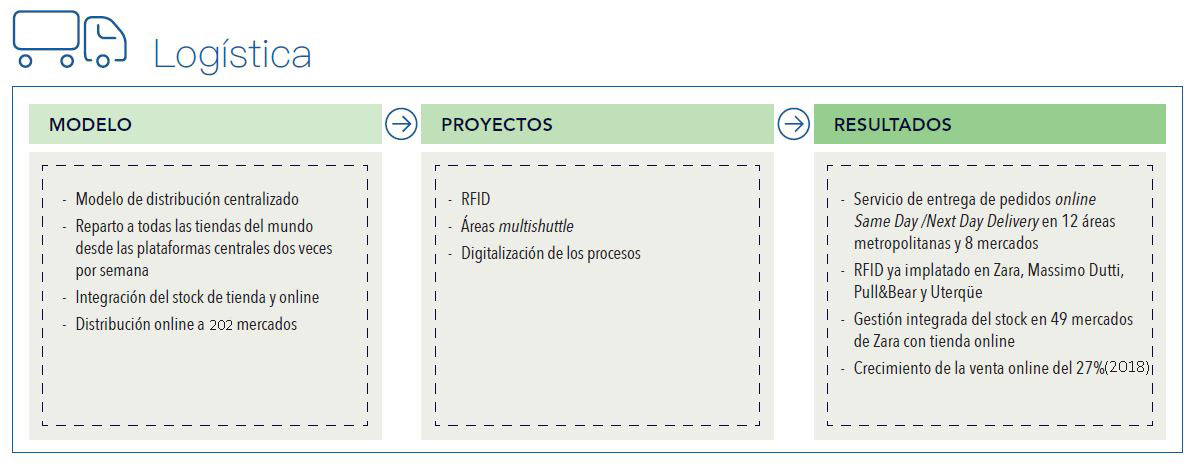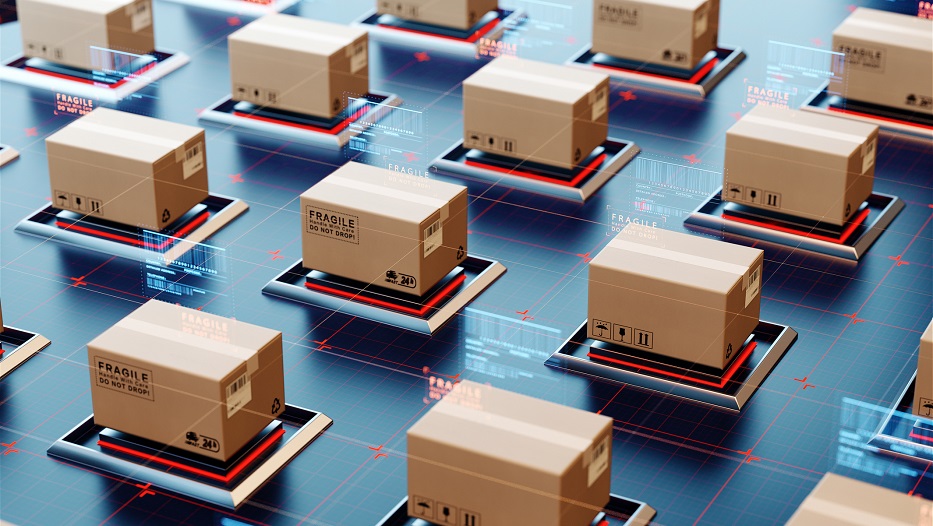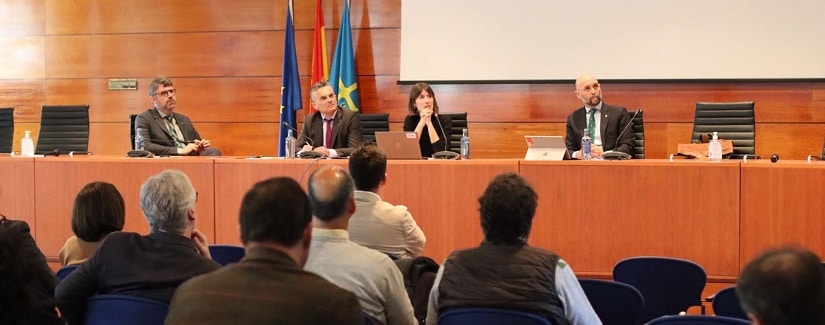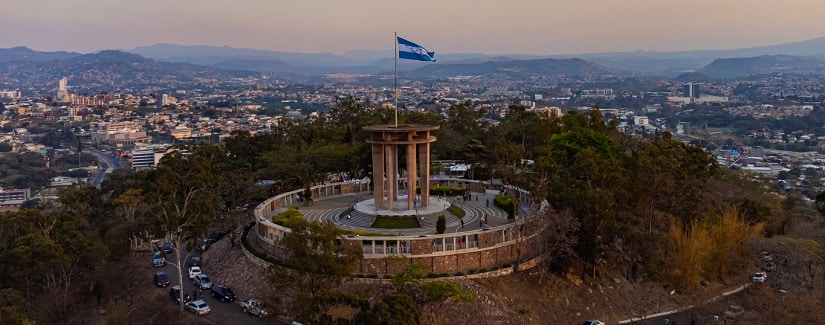The largest clothing retailer in the world, Inditex has emerged as a model for international business. It sells in 202 markets through its online platform and possesses 7,420 stores distributed all over the world. An expansion that would be impossible to achieve without an innovative and detailed logistics system —one of its main keys to success— while managing its worldwide distribution and storage operations from its centralized headquarters in Galicia.
Arteixo houses the main merchandise distribution center, supported by thirteen other warehouses distributed throughout several regions of Spain: Barcelona, Madrid, Guadalajara, León, Alicante, Zaragoza, and A Coruña. Everything produced by the group, regardless of where the product was made, is received in one of these central logistics platforms, all of which are close to the respective headquarters of the group’s eight brands. Indeed, this proximity of production is an indispensable element to guaranteeing agility in distribution. The logistics is complemented by other smaller centers located in different countries and by external logistics operators that distribute a reduced volume of merchandise.
The products arrive at each logistics center from the providers’ factories, and while these are located in 43 countries, 57% are nearby (Spain, Portugal, Turkey, and Morocco). The warehouses have enormous silos for storing the garments and separating them by model, size, and color. A complex automated mechanism allows the requested clothing to be distributed to each store worldwide from the same center.
For Antonio Iglesias, CEO of Logispyme and academic coordinator of the Master’s Program in Logistics and Supply Chain Management + SAP, ERP at ESIC, the main achievement of this logistics system is precisely what has made the brand a world leader: “the flexibility to adapt to the tastes of consumers in all countries, while being able to respond in a very short space of time to any variation in the supply chain from a design, manufacturing, and distribution perspective.” So much so that, from the moment the store or the online customer places the order, the product is supplied within a maximum period of 48 hours to anywhere in the world (36 hours within Europe).
Nevertheless, as Iglesias points out, there are some key aspects that determine the success of this logistics process: inventory control in each of the platforms and proper management of customer order information, either in the stores themselves (where the ongoing stocking service is easier to program) or via e-commerce (where a greater number of orders are managed but with less product volume).
Technological innovation
One of Inditex’s main assets has been its investment in innovation: over the last six years, the company has invested 2 billion euros in technology and logistics in an effort to strengthen its centralized production and distribution structure, optimize costs, and generate the lowest amount of waste in the supply chain.
The entire logistics process would not be possible without large technological systems that provide real-time information. “In the face of one of the biggest problems in retail, which is maintaining as much control as possible over inventories, it is necessary to receive information quickly in order to be able to analyze the evolution of the data and make decisions regarding inventories, human or material resources, etc.” highlights the ESIC instructor. In addition, this centralized system can be sustained thanks to the automation of operational processes in warehouses and the availability of closely linked companies in all merchandise transport processes.
Many of the tools and software programs used in the logistics process are custom made and designed and developed internally. This is the case of multishuttle areas in the Bershka platform in Barcelona and at the Arteixo distribution center. As Iglesias explains, these are automatic systems that serve to temporarily store and sequence products between bulk inventory and other functions such as picking and order assembly. This system increases efficiency and precision for delivery time management and allows the speed of box transport, storage, and collection to be doubled.
Inditex logistics model

Source: Inditex Yearly Report 2018
Sustainable axis
Sustainability is another of the axes upon which Inditex’s logistics is based. As such, it is present in all segments of the process, from the construction and management of logistics centers, to the transport and distribution of goods. “As a company that pursues sustainable logistics, Inditex performs cost control while at the same time exploring how to reduce outsourcing to achieve a balance between economic growth, environmental care, and social well-being,” says Iglesias. To do so, it analyzes the logistical cost in monetary terms, while calculating the cost generated by the company in air pollution, noise, vibrations, and accidents.
In this sense, among other elements of sustainability, eco-efficient lighting systems, thermal insulation, and sophisticated temperature control systems have been introduced into existing logistics platforms. Internal transport within the plants is done using bicycles and electric vehicles, and, over the past year, the group has managed to source 100% of the energy it consumes from renewable sources.
This ecological imperative is also transferred to the providers with whom Inditex works. The company has improved the packing density of each shipment and optimized European distribution through reverse logistics to centralize returns in Spain and prevent trucks from returning empty. In 2018, this improvement in return flows has prevented a total of 5,163 trips, saving nine million kilometers of travel and the associated emissions.
Online sales across the world
A further step in the expansion of Inditex’s business and a real challenge for the group’s logistics system is its commitment that, in 2020, shoppers will be able to purchase “any product” online, from “any” of its brands, and from “any” place in the world – something that even Amazon does not do.

The main logistical challenge to Inditex is its commitment to sell online to anywhere in the world beginning in 2020.
To achieve this, the group anticipates that next year all stores will manage an integrated stock that is identical for both physical stores and online sales. This will simplify the logistics chain, since online orders can be fulfilled from the store itself without another specific inventory being needed. To this effect, a radio frequency identification system (RFID) will be put in place to reflect the order’s exact location at all times.
Although the specific details of the entire process are still unknown, the ESIC instructor believes that the Galician giant will be able to achieve this using the increasingly advanced logistics solutions available that Inditex integrates immediately. The use of airplanes and drones for delivery and partnerships with powerful local partners whose extensive capillarity can ensure delivery, will be crucial aspects.
Of course, he warns of two variables that will affect service: “delivery time will always be higher in places where the company does not have a network of stores”; and the impact that the logistical cost may have on the price of the garment (“it may not be relevant for some, but for others it may render the Retail Price not competitive, which would be reflected in sales”).
Logistical Risks
To prevent these and other risks, under the supervision of the company’s Logistics Committee, the group constantly monitors and analyzes all factors that could negatively affect the objective of achieving maximum efficiency in logistics management.
To mitigate the risk arising from business interruption due to events outside of Inditex (fires, transport strikes, and power cuts, among others), the group optimizes the size and use of all centers in response to the volume of each chain and the particular needs of the geographic area it serves. Therefore, part of each logistics center specializes in the distribution of online merchandise, and each warehouse is configured to take on the storage and distribution needs of other centers during a contingency that paralyzes distribution activities.
Additionally, Inditex implements actions to reduce the effect of these types of risks, maintaining accident prevention and protection measures in all its distribution centers and taking out insurance policies that cover both material damages to facilities and stocks and lost profit derived from an incident.
Furthermore, in the event that the contingency is due to withheld merchandise during transport, Inditex has a network of agents at supply and distribution points who cover the alternative transport routes for merchandise.
Colaborator

Antonio Luis Iglesias is an economist who holds a master’s degree in Business Management and Marketing from ESIC and specializes in Logistics and Supply Chain Management (SCM). He began his professional career in the world of consumer product distribution as a logistics technician at Simago, before working in Logistics Management at Central Cooperativa Sociedad.
Over the past twenty years, he has been active in the world of consulting, working for nationally-renowned consulting firms on behalf of numerous companies from different sectors (FNAC, The Phone House, Orange, Gefco, ECI, Royal Canin, etc.). He was the Area Manager for Supply Chain Management of the Enfoque 5 Consultores group. Subsequently, he began at the Balanced Life group, where he is presently working.
He is currently the CEO of Logispyme, a company providing logistics consulting to SMEs, and an academic coordinator of the Master’s Program in Logistics and Supply Chain Management + SAP, ERP at ESIC.
His work as a speaker and columnist has also brought him acclaim. He is the co-author of the Manual de Logística en Distribución Comercial (Business Distribution Logistics Manual) and the author of the blog http://logispyme.wordpress.com.




